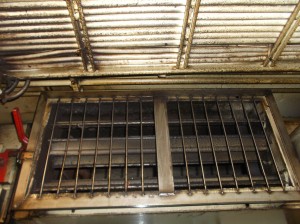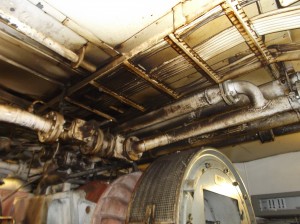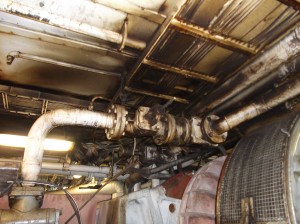Oil Mist and Machinery Space Fires

 Engineroom 2015
 Engineroom 2015
 Engineroom 2015
OIL MIST AND MACHINERY SPACE FIRES
by
Dr MH Holness PhD, C Chem, FRSC, M Inst Pet. (Petrohaz)
for
Quality Monitoring Instruments Ltd Ref. PO 065721 7 June 1995
Summary
A review is presented of the role of oil mist as a principal agent in machinery space fires. The ways in which oil mist can be produced are described and the distinction between mist and spray. The contrast between the oil mist conditions inside crankcases and that in the general atmosphere in machinery spaces is discussed. Methods of measuring oil mist and spray are described and equipment suitable for monitoring conditions inside machinery and in machinery spaces is discussed. Recommendations are made to improve safety on board ship and in industrial plant.
Contents
Introduction
Burning of Liquid Fuels
Properties of Oil Droplets
Crankcase and Gearcase Explosions
Fires in Machinery Compartments
Oil Drops in the Atmosphere
Detection of Oil Mist 5 Conclusions
Recommendation
References
Oil Mist and Machinery Space Fires
by
Dr MH Holness (Petrohaz)
Introduction
A large proportion of machinery space fires have been caused by fuel or lubricant leaks. However,
leaks of this kind, while providing fuel, do not inevitably lead to a fire. In most cases a hot surface of
some kind has produced the conditions necessary to produce flammability and has also acted as
the ignition source. A typical set of circumstances is a leak of fuel from an injector pipe, the fuel falls
onto (say) the turbocharger casing, vaporises and is ignited. This sounds like simple cause and
effect, however there are a series of intermediate stages which ought to be considered.
Burning of Liquid Fuels
Liquid fuels do not burn as liquid, they burn only as vapour. Inevitably, the conversion from liquid to
vapour must require the input of some energy. This can be provided by compression in an engine
or with a hot surface, a spark or a flame.
Outside of an engine or boiler, oil products not usually regarded as "fuel", may also burn under
uncontrolled conditions producing a fire or explosion. Fuel from an injector, under pressure, may
escape as a jet or spray so that it can reach a hot surface. At this point it will vaporise and form a
cloud of vapour expanding away from the heat. As the vapour moves away from the
surface, it cools and re-condenses, forming a cloud of fine mist droplets. During this time, the droplets of fuel near to the hot surface may reach a sufficiently high temperature for spontaneous
ignition to occur and, after a delay period, the whole mist cloud becomes ignited. Similarly, hydraulic
oil from a high pressure line will follow the same mechanism if it contacts a hot surface. The same
process can take place inside machinery, if a mechanical failure occurs creating a high
temperature. This mechanism is well understood and has been described in relation to crankcase
explosions in the 1950's (1), and to marine gearbox explosions in the 1970's and 80's (2).
|



